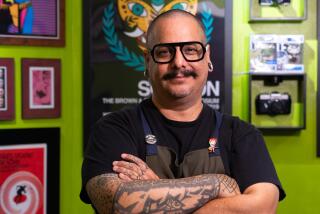Carlos Bueno, 60; L.A. Art Pioneer
Carlos Bueno, a draftsman, painter and muralist who helped launch the Chicano art movement in the 1970s as co-founder of an important East Los Angeles art center, died of heart failure Aug. 18 in Mazatlan, Mexico. He was 60.
He joined Sister Karen Boccalero and photographer Antonio Ibanez in starting a community art project in 1971 that evolved into Self-Help Graphics, the Eastside institution that has nurtured such notable artists as Gronk and Pattsi Valdez.
Bueno encouraged Self-Help Graphics to sponsor the first Dia de los Muertos, or Day of the Dead, celebration in Los Angeles in 1972. Three decades later, the holiday, which has roots in pre-Columbian Mexico, has blossomed into an annual cultural event rivaling Halloween that has inspired art, music and poetry and has become a source of cultural pride.
“He bridged that whole idea, the connection between Mexico and Chicanos here,” said Kathy Gallegos, owner of Avenue 50 Studio in Highland Park, which in April hosted Bueno’s last solo show. “What he did was influence artists to look back to their roots in Mexico to find inspiration. That is the root of the Chicano movement.”
Bueno was not well known in the United States, although recent gallery shows were beginning to revive interest in his work. Born in Cuernavaca, he spent the 1970s in Los Angeles but returned to Mexico about 20 years ago.
When he first came to Los Angeles, the Chicano power movement was underway. He shared his knowledge of Mexican culture with Boccalero, a Franciscan nun and student of silk-screen artist Corita Kent, who had a garage studio in Boyle Heights.
Bueno and his companion, Ibanez, helped Boccalero start the Barrio Mobile Art project, which brought workshops and a van loaded with art supplies to schools, housing projects and parks. That effort turned into Self-Help Graphics, the grass-roots nonprofit center that over the years has become well-known for its printmaking program and support of Mexican American artists.
In 1972 Self-Help Graphics wanted to sponsor a festival that would bring attention to the center and promote Chicano culture.
“Sister Karen wanted to have a Mexican celebration that was not one of the official ones--Independence Day or Cinco de Mayo,” said artist Alfredo de Batuc. “They started to throw ideas around. She asked for something like Thanksgiving. Carlos decided on Dia de los Muertos.”
The Nov. 2 holiday became the occasion for citywide festivities in parks, art galleries, theaters, community centers and schools. It encouraged Chicano artists to explore their Mexican heritage and provided a forum for expression and cultural pride.
In recent years, artists in Mexico have begun to embrace the Day of the Dead and other Chicano iconography, Gallegos said, bringing Bueno’s influence full circle.
Bueno painted murals in Los Angeles and elsewhere in the Southwest; all are believed to be gone except for one in a San Jose church.
Pen-and-ink drawing was considered his forte. Known for their elegant, fluid lines, his drawings had a filigree refinement and showed the influence of Gustav Klimt and Aubrey Beardsley.
For his subjects Bueno often chose people at society’s fringes, including cholos, prostitutes, transvestites and street hustlers. He produced portraits of women as mermaids, icons of his home in the port city of Mazatlan.
Never an ivory tower artist, Bueno spent the last several years of his life teaching inmates at El Cereso Jail in Mazatlan. He taught free art classes and directed a group of artist inmates who called themselves Los Camaleones, or the Chameleons.
“He said he tried to depict people considered at the lower rung but in a way that they had humanity still. He had a lot of respect for the low, the poor,” said Ricardo Munoz, an administrative law judge and collector of Bueno’s works.
Bueno often integrated the name of his longtime partner, Ibanez, into his signature, signing his drawings and other works Ibanez y Bueno.
He was the last surviving founder of Self-Help Graphics. Boccalero and Ibanez died in the late 1990s.
Bueno lost a lung to cancer and had been in failing health for several years. He is survived by a sister, Norma Aracely Bueno Poblatt of Mazatlan.
More to Read
Sign up for Essential California
The most important California stories and recommendations in your inbox every morning.
You may occasionally receive promotional content from the Los Angeles Times.










